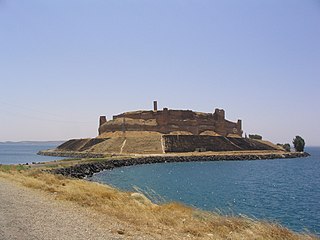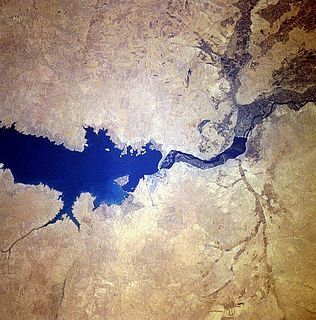
The geography of Malta is dominated by water. Malta is an archipelago of coralline limestone, located in the Mediterranean Sea, 81 kilometres south of Sicily, Italy, and nearly 300 km north (Libya) and northeast (Tunisia) of Africa. Although Malta is situated in Southern Europe, it is located farther south than Tunis, capital of Tunisia, Algiers, capital of Algeria, Tangier in Morocco and also Aleppo in Syria, and Mosul in Iraq in the Middle East. Only the three largest islands – Malta, Gozo and Comino – are inhabited. Other (uninhabited) islands are: Cominotto, Filfla and the St.Paul's Islands. The country is approximately 316 km2 in area. Numerous bays along the indented coastline of the islands provide harbours. The landscape of the islands is characterised by high hills with terraced fields. The highest point, at 253 metres, Ta' Zuta on mainland Malta. The capital is Valletta.

Latakia is the principal port city of Syria, as well as the capital of the Latakia Governorate. Historically, it has also been known as Laodicea in Syria or Laodicea ad Mare. In addition to serving as a port, the city is a manufacturing center for surrounding agricultural towns and villages. According to the 2004 official census, the population of the city is 383,786, Its population greatly increased as a result of the ongoing Syrian Civil War due to the influx of refugees from rebel and terrorist held areas. It is the 4th-largest city in Syria after Aleppo, Damascus and Homs, and it borders Tartus to the south, Hama to the east, and Idlib to the north while Cape Apostolos Andreas, the most north-eastern tip of Cyprus is about 68 miles (109 km) away.
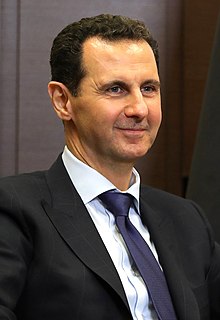
Bashar Hafez al-Assad is a Syrian politician who has been the President of Syria since 17 July 2000. In addition, he is commander-in-chief of the Syrian Armed Forces and Regional Secretary of the Arab Socialist Ba'ath Party's branch in Syria. His father, Hafez al-Assad, was President of Syria from 1971 to 2000.

Arwad, the classical Aradus, is a town in Syria on an eponymous island in the Mediterranean Sea. It is the administrative center of the Arwad Subdistrict (nahiyah), of which it is the only locality. It is the only inhabited island in Syria. It is located 3 km (1.9 mi) from Tartus, Syria's second-largest port. Today, Arwad is mainly a fishing town. According to the Syria Central Bureau of Statistics, during the 2004 census, it had a population of 4,403, predominantly Sunni Muslims. Plans were unveiled in May 2016 to renovate the island to become a tourist attraction.

The Tabqa Dam, or al-Thawra Dam as it is also named, most commonly known as Euphrates Dam, is an earthen dam on the Euphrates, located 40 kilometres (25 mi) upstream from the city of Raqqa in Raqqa Governorate, Syria. The city of Al-Thawrah is located immediately south of the dam. The dam is 60 metres (200 ft) high and 4.5 kilometres (2.8 mi) long and is the largest dam in Syria. Its construction led to the creation of Lake Assad, Syria's largest water reservoir. The dam was constructed between 1968 and 1973 with help from the Soviet Union. At the same time, an international effort was made to excavate and document as many archaeological remains as possible in the area of the future lake before they would be flooded by the rising water. When the flow of the Euphrates was reduced in 1974 to fill the lake behind the dam, a dispute broke out between Syria and Iraq that was settled by intervention from Saudi Arabia and the Soviet Union. The dam was originally built to generate hydroelectric power, as well as irrigate lands on both sides of the Euphrates. The dam has not reached its full potential in either of these objectives.
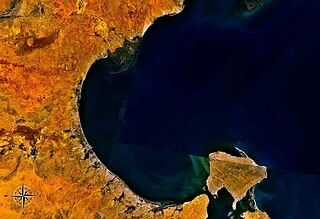
The Gulf of Gabes, also known as Lesser Syrtis, contrasting with the Greater Syrtis in Libya, is a gulf on Tunisia's east coast in the Mediterranean Sea, off North Africa. The gulf roughly spans the coast from Sfax to Djerba. At the head of the gulf is the city of Gabès (Ghannouche) where the tides have a large range of up to 2.1 m at spring tides. Both Gabès and Sfax are major ports on the gulf, supporting sponge and tuna fisheries, with Gabès being the economic and administrative center.

Qaruh Island is an island belonging to the state of Kuwait, which received its name from the large amounts of petroleum sediments in the area. It is the smallest of the nine islands, and also the furthest island from the Kuwaiti mainland. It is located 37.5 kilometres east of the mainland coast, and 17 kilometres northeast of Umm al Maradim. The island is roughly 275 meters long by 175 meters at its widest (area about 3.5 ha. The island was also the first part of Kuwaiti soil that was liberated from Iraq during the Gulf War on January 21, 1991.

Latakia Governorate is one of the fourteen governorates (provinces) of Syria. It is situated in western Syria, bordering Turkey. Its reported area varies in different sources from 2,297 km² to 2,437 km². The governorate has a population of 991,000. Members of the Alawite sect form a majority in the governorate, although Armenians, Turkmen, and Sunni Kurds form the majorities in the Kessab, Jabal Turkman, and Jabal al-Akrad regions respectively. The capital of Latakia had, by 2010 estimates, 400,000 inhabitants, 50% of whom were Alawites, 30% were Sunni, and 20% Christian.

Jumeirah Beach Residence is a 1.7 kilometres (1.1 mi) long, 2 square kilometres (0.77 sq mi) gross floor area waterfront community located against the Persian Gulf in Dubai Marina in Dubai, United Arab Emirates. It is a residential development and contains 40 towers. JBR can accommodate about 15,000 people, living in its apartments and hotel rooms. The Project has 6,917 apartments, from 900 sq ft (84 m2) studios to 5,500 sq ft (510 m2) penthouses. JBR has a total of six residential blocks, Shams, Amwaj, Rimal, Bahar, Sadaf and Murjan. JBR is within walking distance to Dubai Marina and Dubai Metro.
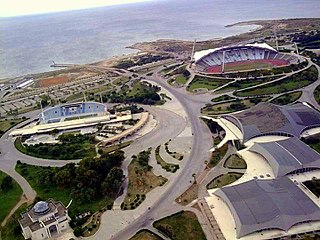
Latakia Sports City, also known as al-Assad Sports City, is a sports complex in Latakia, Syria. It was opened in 1987 on the occasion of the 10th Mediterranean Games hosted by Latakia during the same year.

Umayyad Square is a large and important square in Damascus, Syria. It connects the city center with several important highways and areas and contains various important buildings including but not limited to the Ministry of Defense, Syria's national Opera house and the headquarters of the Syrian Armed Forces.

Burj Islam is a village in northwestern Syria, administratively part of the Latakia Governorate, located north of Latakia. Nearby localities include Salib al-Turkman to the north, al-Shabatliyah to the northeast, Ayn al-Bayda to the east and al-Shamiyah to the south. According to the Syria Central Bureau of Statistics, the village had a population of 5,652 in the 2004 census. Its inhabitants are predominantly Sunni Muslims from Turkmen ethnicity.
The Siege of Rastan and Talbiseh was an operation by the Syrian Army during the Syrian uprising. On 28 May 2011, after protests and armed revolt, the Syrian Army launched an operation in al-Rastan, a city of an estimated 50,000 residents 20 kilometers north of Homs, and the neighboring town of Talbiseh, which resulted in the suppression of the protests and numerous deaths. The Syrian Army met some armed opposition during the operation.

The 4th Armoured Division is an elite formation of the Syrian Army whose primary purpose is to defend the Syrian government from internal and external threats.

The Bayda and Baniyas massacres were two widely reported on massacres that occurred in May 2013 in the village of Bayda and the city of Baniyas, in Tartus Governorate, Syria, where Syrian Army troops, supported by paramilitaries, killed civilians in the Sunni village respectively the Sunni part of the city. The killings were supposedly in retaliation for an earlier rebel attack near the town that left at least half a dozen soldiers dead.

The border between the Syrian Arab Republic and the Republic of Turkey is about 822 kilometres (511 mi) long. It runs across Upper Mesopotamia for some 400 kilometres (250 mi), crossing the Euphrates and reaching as far as the Tigris. It follows the Southern Turkish stretch of the Baghdad Railway, roughly along the 37th parallel between the 37th and 42nd eastern meridians. In the west, it surrounds the Turkish Hatay Province, following the course of the Orontes River and reaching the Mediterranean Sea coast at the foot of Jebel Aqra.

The border between the Syrian Arab Republic and the Lebanese Republic runs for a total length of about 375 kilometres (233 mi); it accounts for most of the land border of Lebanon . It runs eastward from the Mediterranean coast, following the Nahr al-Kabir al-Janoubi. The Lebanese border forms a salient to include the villages of Karha and Knaisse Akkar in the northwest of Akkar District, just west of the Syrian Lake Homs, and again turns to the south-east, cutting across the Orontes and the trans-Beqaa road between Qaa and Al-Qusayr, reaching the Anti-Lebanon mountains at about 34.22°N 36.60°E.






